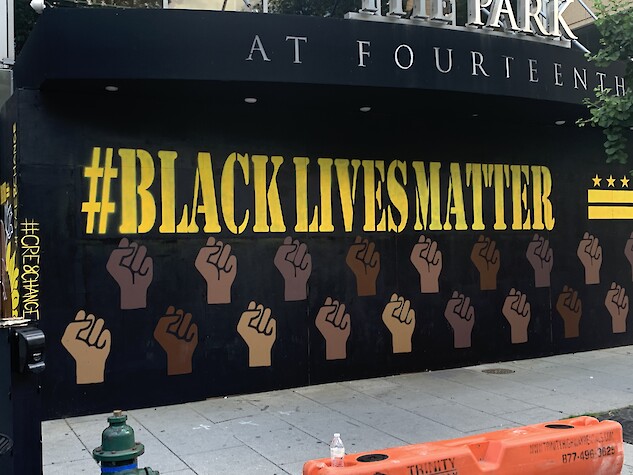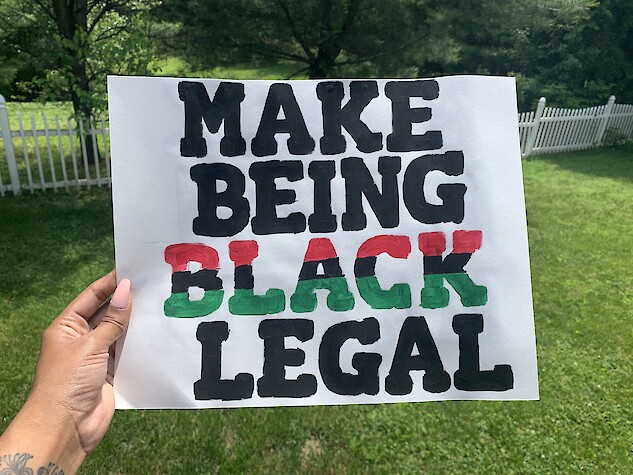Why Now? A Critique of the Chesapeake Bay Program’s Diversity, Equity, Justice and Inclusion Action Plan
Faith Taylor ·This week our class had Kristin Saunders from the Chesapeake Bay Program (CBP) come and discuss the efforts that the program has made to increase Diversity, Equity, Justice, and Inclusion (DEJI). Sanders began the class by acknowledging that the Clean Water Act (CWA) authorized the creation of the Chesapeake Bay Program. The CBP generated 10 goals for the 2014 Watershed Agreement, and improving diversity outcomes is part of the stewardship goal. Sanders also noted that when the agreement was being drafted there was a large debate about whether climate change and diversity should be addressed at all within the document. Part of this gridlock can be attributed to the complex system of partnership members that make up the CBP. These members include the U.S Environmental Protection Agency (EPA) and a variety of other federal and state partners.
Fast forward to 2021, the CBP has had no problem addressing the need to increase the conversations about diversity and climate change. Although this program has been described as complex, I would say that it is critically lacking in some of the most foundational components for engaging with underserved communities in the Chesapeake Bay community: stakeholder engagement. For such a complex organization, it is a shame that the lack of stakeholder engagement in the development of their DEJI action plan was allowed to continue and go unchecked. Like many other predominantly white environmental organizations, the Chesapeake Bay Program has lacked representation in its leadership and membership while simultaneously underservering the diverse needs of communities of color and low-income communities. In her 2015 paper, Dr. Dorceta E. Taylor notes that in 1990 people of color represented less than 2% of the membership in the top four environmental organizations. In 2014, people of color accounted for approximately 12% of the staff in government environmental agencies.
The members of the CBP acknowledge that they have underserved communities in the Chesapeake Bay area, but the development of a DEJI action plan that included little to no meaningful input from the communities that would be the beneficiaries of this plan is an oversight that cannot go unaddressed. How can this plan be equitable when community members are only asked for input on the action plan after it has been entirely developed? Should this form of engagement even be considered “meaningful” or is it just merely a continuation of the system of engagement that has abandoned these communities in the first place? Arnstein (1969) describes citizen participation as “the redistribution of power that enables the have-not citizens, presently excluded from the political and economic processes, to be deliberately included in the future.” One could hardly describe the lack of inclusion in the initial creation of the DEJI action plan as a meaningful way to distribute power back into the communities that have been overlooked and underserved by the CBP. Arnstein describes eight levels of engagement: Manipulation → Therapy → Informing → Consultation → Placation → Partnership → Delegated Power → Citizen Control. I would describe the action of the CBP as “Consultation” at best. Arnstein notes that “the most frequent methods used for consulting people are attitude surveys, neighborhood meetings, and public hearings'' and that “this rung of the ladder is still a sham since it offers no assurance that citizen concerns and ideas will be taken into account.” Given that, for a certain time period, the CBP will be allowing for public comment on the action plan that has already been developed, and that there is no guarantee the comments made during the public comment period will actually be used used to revise the action plan, it makes sense that the actions of the CBP are seen as “consultation.” It is also important to note that the phase of consultation is considered to be a degree of tokenism. Tokenism is defined as “the practice of doing something (such as hiring a person who belongs to a minority group) only to prevent criticism and give the appearance that people are being treated fairly” (Sherrer, 2018).

One of the key remarks made in the class was that the CBP needs to be held accountable for the lack of interest in increasing diversity in previous years of the program's existence. The question I consistently ask myself when I see actions like those of the CBP is “why now?” Why didn’t you care about diversity and inclusion before 2014? My Black life has ALWAYS mattered so why is it that you only acknowledge that #BlackLivesMatter when it's a trending topic on twitter?

The CBP has made an effort to acknowledge that there needs to be an increase in diversity and inclusion, but performative acts that lack actual inclusion of the underserved is not the way to move forward. What we should do is defund the CBP who has long since abandoned communities of color and low-income communities in the Chesapeake Bay area. These funds should then be redistributed to the local environmental organizations who have been doing the work the CBP refused to, the organizations who cared about the underserved communities before the terms “diversity,” “equity,” and “inclusion” became trending topics and buzz words.
If the CBP wants to have any form of meaningful diversity and inclusion, then there must be conscious efforts at all stages of development. Hire contractors from the communities that you’ve abandoned! Provide reparations for the communities that you underserved when you were providing services to those with privilege. Restructure your leadership team to be composed of diverse people other than just white men and women. Reach out to communities of color and low-income communities in the Chesapeake area and ask them what resources your program can provide. Think critically about the role that your organization has played in promoting racist, sexist, capitalist, ableist, facist, imperialist, and colonialist ideas about nature and the environmental movement.

References
Arnstein, S. R. (1969). A ladder of citizen participation. Journal of the American Institute of Planners, 35(4), 216-224. doi:10.1080/01944366908977225.
Sherrer, K. (2020, June 22). What is tokenism, and why does it matter in the workplace? Retrieved from https://business.vanderbilt.edu/news/2018/02/26/tokenism-in-the-workplace/
Taylor, D. E. (2015). Gender and racial diversity in environmental organizations: Uneven accomplishments and cause for concern. Environmental Justice, 8(5), 165-180. doi:10.1089/env.2015.0018.
Disclaimer: The views expressed in this blog post are solely those of the author and do not reflect the views and opinions of the University of Maryland, College Park, the University of Maryland Center for Environmental Science, or any other institution or organization upon which the author is affiliated with.
About the author
Faith Taylor

Faith Taylor is a second year master's student at the University of Maryland College Park. She is in the Marine, Estuarine and Environmental Sciences program and her concentration is in environment and society. She is advised by Dr. Michael Paolisso. Her thesis work focuses on using a comparative analysis to assess how environmental injustices are captured by case studies and screening tools. Her interests include race, environmental justice, environmental racism and vulnerability.
Next Post > Facilitating a Great Barrier Reef partnership workshop in Brisbane
Comments
-
Taylor Gedeon 5 years ago
What an incredible, well-written, and crucial blog. Your suggestions for forms of meaningful diversity and inclusion are incredibly clear and actionable. Any agency, organization, and person reading this should take note and IMMEDIATELY begin working towards these. Meaningful action, not performative.
Thank you for saying what needed to be said.
-
Isabel Sullivan 5 years ago
Well said Faith! It is definitely an issue with stakeholder engagement being low in these different environmental groups. I have also seen many organizations claim to improve when these trends come along on social media but after the trends die down, nothing substantial is done. It seems to me that a restructuring could allow for better implementation of stakeholder involvement and create a lasting difference instead of a brief change to appease a trend.
-
Andrea Miralles-Barboza 5 years ago
YES so much yes. For me the visual of the ladder and the steps that need to be taken to actually re-empower disenfranchised people was very powerful
-
Katrina Kelly 5 years ago
Faith, your blog is powerful and catalytic. Actively seeking answers to the hard questions, provides an opportunity to engage with each other in meaningful (albeit difficult) ways which essential for the evolution of mankind. Your reference to Arstein's engagement principles offers guideposts to a balance path of justice that will allow all people to breathe and thrive in the American environment. Brava!
-
Jehnae 5 years ago
This is one of the most powerful blogs I have read. I would have to agree with your question of "why now". It seems for the past few years everyone has been on this diversity and inclusion wave but no one is really taking the time to actually do research and understand these communities. Like you said its just something thats trending at the moment.
-
Amber 5 years ago
The current trendiness of DEIJ makes me very concerned that these organizations will not follow through with what is needed (from the top down and bottom up) to truly address these issues. Stakeholder involvement should be mission-critical to every step. Thank you for your perspective, these great resources, and for providing some great solutions.
-
Megan 5 years ago
Defunding the CBP is a call that absolutely breaks performative conversations from what is understood to be a comfortable shift in power to a necessary shift in power. Your points are critical without academic citations but in the context of this blog series adding those details and contextualizing this report makes the importance of this call undeniable. Great work.
-
Sarah 5 years ago
Faith, your enthusiasm and spunk within this class has been exquisite, and I knew your blog post would have the same energy. Your passion for this topic shows through in this blog. When reading your statements, I can hear how important this topic is and how dedicated you are in EJ. Enthusiasm and passion is what, I believe, drives change.
-
Nylah McClain 5 years ago
Many great points raised in your blog! It really shows how passionate and educated on the subject of accountability you are. Really question the why in an organization’s move to be more inclusive or more diverse is really so important. I don’t think organization’s should be given brownie points for following a fad no matter how impactful their move is. Unless they are open about their hesitance or wrongdoing prior to being inclusive/diverse how can it really be proven that they organization has grown?
-
Imani Black 5 years ago
To this day, the conversation about your blog is still one of my favorites. It's these raw and transparent discussions that start shifting the actions and thoughts are the people around us. I admire the power in your words in this blog along with the dialogue you unapologetically always bring to our class.
-
Peter 5 years ago
A good analysis of some of the actions and views of CBP. Although I don't familiar with the internals of these institutions, your blog has persuaded me to reconsider my future donation to CBP. At the same time, I am also very worried about the situation of Asians in the United States. They should also be taken seriously and given the corresponding political rights, instead of becoming obscure after the recent campaign.
-
Ashley Silver 5 years ago
You have so much passion in your blog. I love how you express the lack of inclusion of people of color on environmental justice issues when we are the most impacted by them.
-
Shakira 5 years ago
Faith, anything you say, rather verbally or written, enlightens me and makes me dig deeper. You also raised the question that I and so many others in my community have asked and have conversations about: "why now"? As Jehnae said, it's trending, so are we going to keep this energy, when the attention dies down? This blog was EVERYTHING and then some. I appreciate the honesty and not watering it down to fit the narrative of others, and making the audience face the reality some refuse to acknowledge.
-
Imani Wilburn 5 years ago
As expected when I clicked your blog, you are completely on top of this! I always love when my fellow students teach me and enlighten me, which is all you have done this whole semester. This is clearly what you're passionate about and it is so easy to tell. You go into so much detail and I absolutely love your view and take on things, as well as how you're so assertive and confident about everything you say and write. It keeps being a privilege to be in a class like this with someone like you, I am amazed at every step and am in complete admiration.

